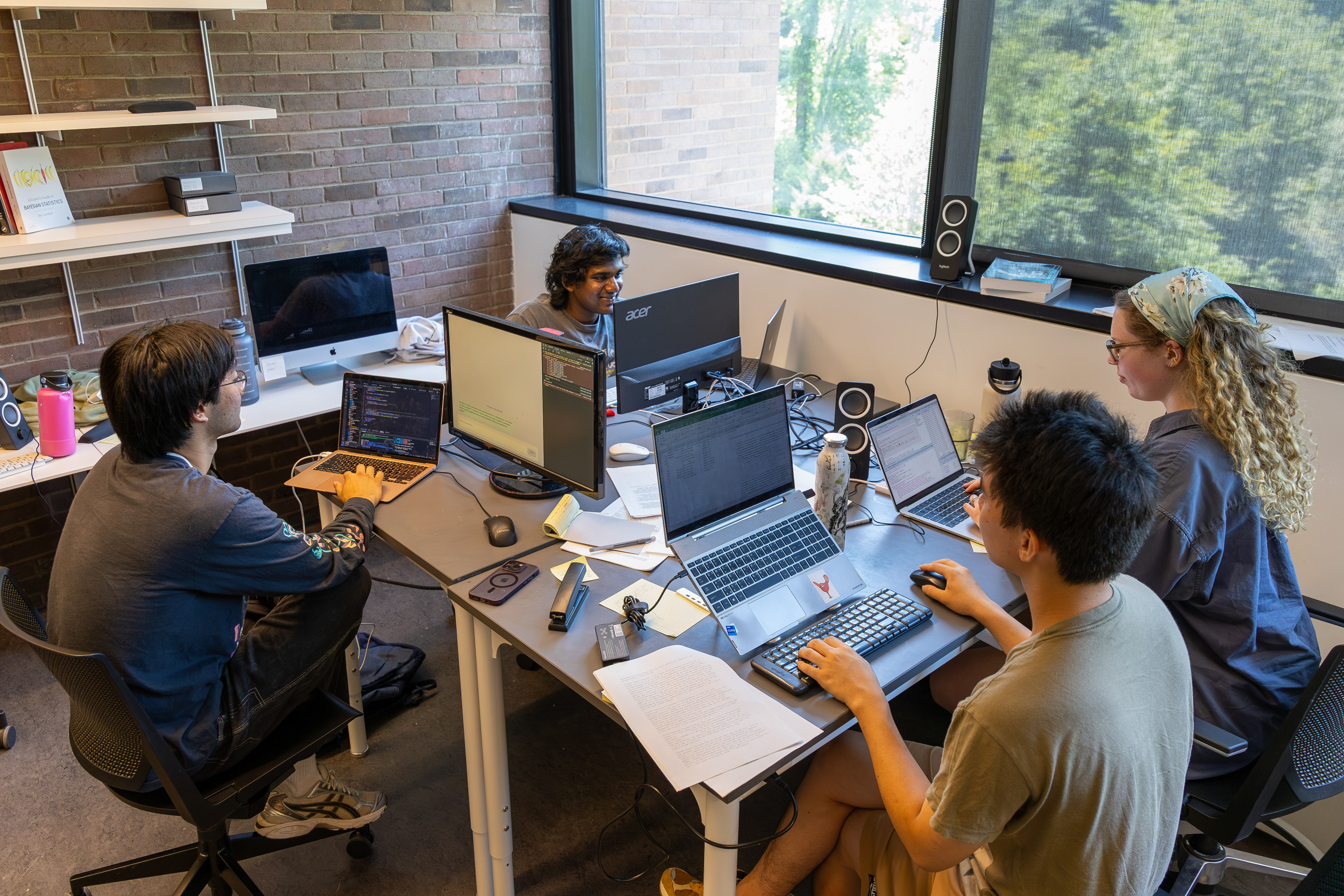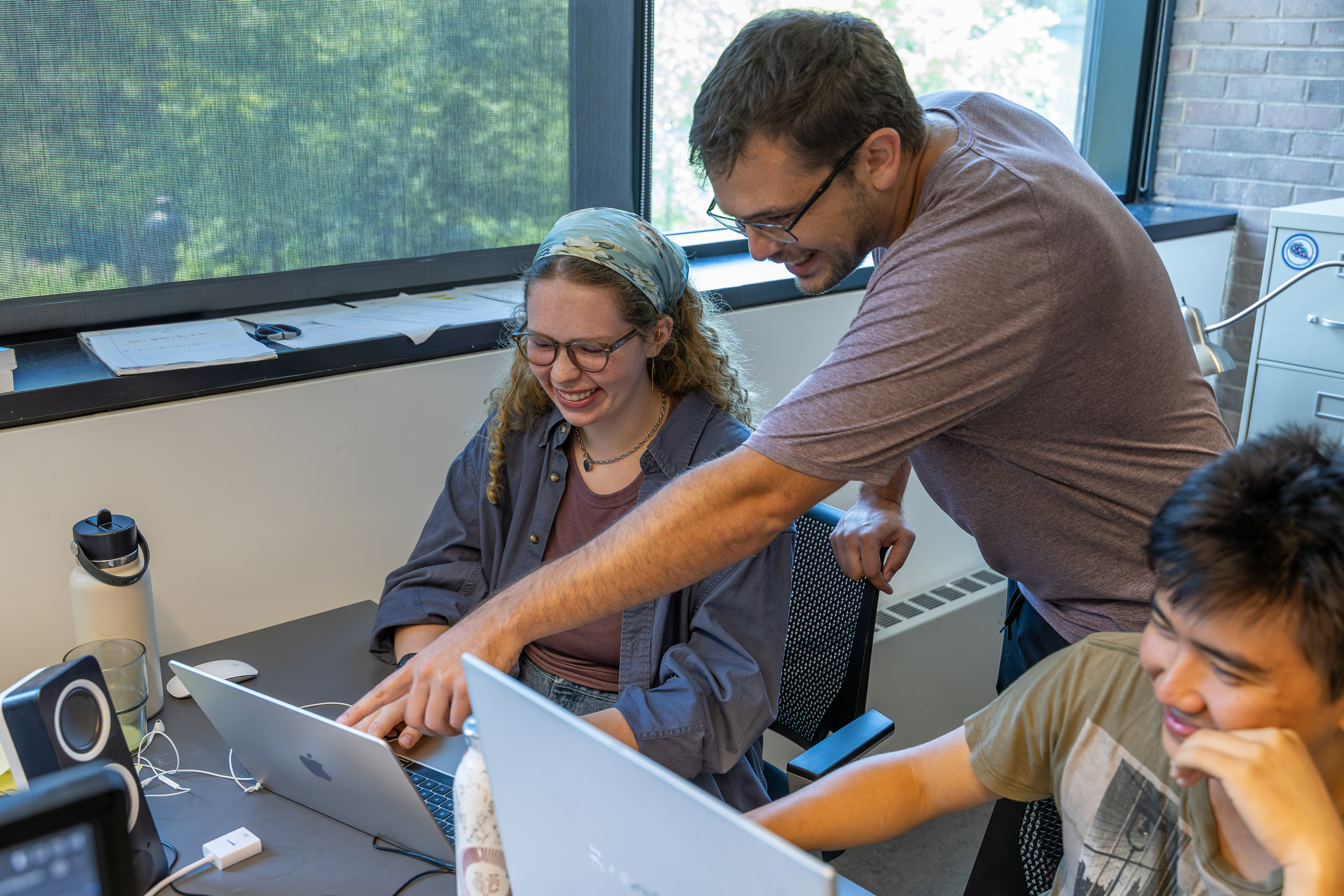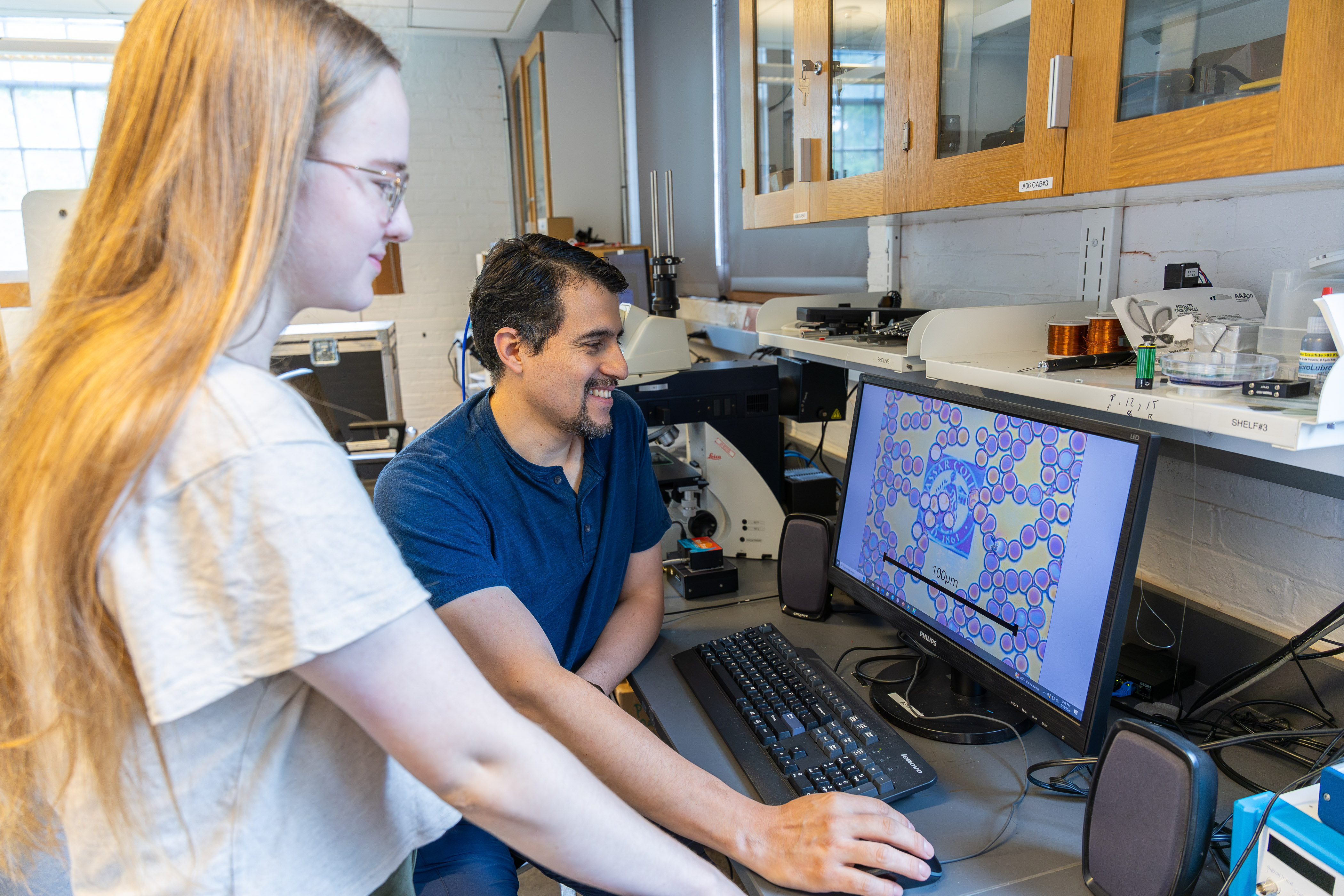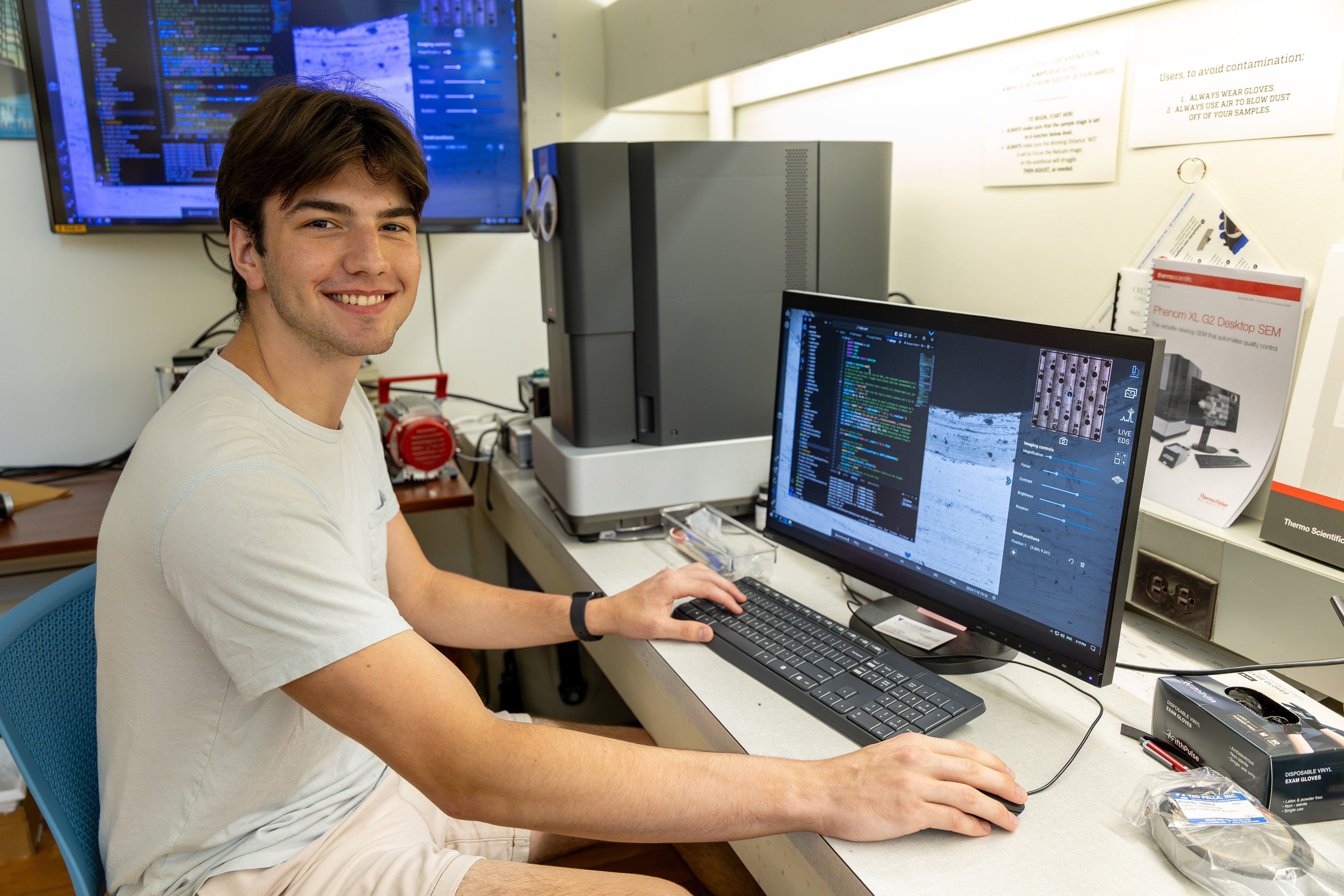URSI Provides a Deep Dive into Nanotech and AI
Vassar’s Undergraduate Research Summer Institute (URSI) allows approximately 80 students to take part in immersive science research projects. This year’s student researchers will present their work at a campus symposium on September 25. The keynote speaker will be Dr. Kate Freeman, Professor of Geosciences at Pennsylvania State University. Dr. Freeman is a member of the National Academy of Sciences and a preeminent scholar in several fields, including astrobiology and geochemistry.
Funding for the URSI program is provided by Vassar’s Computing and Information Services, the Faculty Start-Up Fund, the Office of the Dean of the Faculty, the Environmental Research Institute the National Science Foundation, the National Institutes of Health, and numerous private foundations and endowments created by Vassar alums.
Following are reports on URSI projects this summer that involved research in two cutting-edge facets of science: artificial intelligence and nanotechnology
Students ‘Teach’ AI Bot to Help Us Tone Down Conversations on Controversial Issues

Over the past few years, scientists have issued dire warnings about the dangers posed by the rise of artificial intelligence technology. At Vassar, Associate Professor of Cognitive Science Joshua de Leeuw and four of his students spent the summer exploring the feasibility of using AI in a positive way. They are “teaching” a ChatGPT bot to converse with users about hot-button topics in a private, safe environment. Their goal is to help users become more comfortable discussing these topics, in hopes of facilitating richer person-to-person conversations.
“We began our research by finding out what had already been done in this field, and we looked at what makes people more open to discussing strongly held beliefs,” de Leeuw said. “Then we began to develop strategies for the bot that matched successful human approaches.” One of these strategies is to explain alternative points of view. “The bot acknowledges the arguments advanced by the participants, but then offers examples of other points of view,” Jacqueline Adelmann ’26 explained.
Using a research website, URSI students Adelmann and Ian Ho ’25 recruited 40 volunteers from across the United States with a wide spectrum of political beliefs and picked several potentially contentious topics, such as a mandatory vaccination policy for certain diseases, for the specially engineered bot to discuss with them. Two other students, Victor Zhang ’25 and Niranjan Baskaran ’27, were tasked with creating the software that would allow the team to implement the conversation strategies and record the conversations. Assistant Professor of Cognitive Science Stephen Flusberg also acted as an unofficial mentor for the project.
The research participants were given questionnaires before and after their conversations to measure whether their views on the topic had shifted, and whether they were more willing to have conversations with people who might disagree with them.
Did the AI bot succeed in making people more open to have difficult conversations? The students say it’s too early to say so definitively, but there were encouraging signs during their research. “Forty people is a small sample size,” Ho said, “but many of the people we surveyed said some of their opinions had been modified after their conversations.”
The students described their URSI experience as enriching and rewarding. “It was great to be able to tackle a topic for a long period of time, and it’s something that’s meaningful and has real-word applications,” Ho said. “Josh cares a lot about this project, but we were given a lot of leeway in how we approached it. It’s something I’d like to continue to work on.”
Baskaran said he too appreciated the flexibility he was given to attacking the problem. “Some of the work had a steep learning curve for me,” he said, “but taking part in this project reinforced my appreciation for working on a concrete problem rather than the theoretical tasks we are given in our classes. The experience has made my thinking more structured and improved my problem-solving skills.”

De Leeuw said the group’s next task would be to add more people as test subjects for the experiment. “Ultimately, we’d like to have hundreds of participants, and when we have enough data, the students and I will write a paper on our findings,” he said.
De Leeuw lauded the students for their work throughout the summer. “This topic required people with a broad range of skills, and I have been impressed with what they have accomplished,” he said. As for the future of the chatbot, de Leeuw was cautiously optimistic. “We are being careful about making it available before we have clear data about the impact of these conversations, but our goal is to make this system available to the Vassar community and the general public.”
Students Create Images That Are Really, Really Small

Microscopy is the scientific discipline that involves using microscopes to observe and investigate objects that are beyond the human eye’s reach, such as insects, bacteria, cells, micro- and nano-devices, and even molecules and atoms. This summer, Assistant Professor of Physics Juan M. Merlo-Ramírez and his URSI team continued research that Merlo began last year to create tiny devices, as small as one 200th of the width of a human hair, with the help of a Scanning Electron Microscope (SEM). Furthermore, they were able to produce images on individual cells. James Zuckerman ’26 and Lissus Murataj ’27 used an SEM to fabricate patterns on these tiny polymers. Joanna Wahl ’27 learned to scale up replicas of these objects and other micro-scale devices on a 3D printer.
Merlo said the procedures he and his students used in their research this summer had many potential uses, particularly in nanoscience and medicine. In one experiment, Merlo and his students were able to write the letter A on a single red blood cell. “This could find important applications in the future, such as tracking of cells inside the human body for discovery or treatment of diseases if we find a way to keep the cells alive,” he said.
Zuckerman and Murataj said they had had no previous training in using the SEM but learned the techniques within a couple of weeks. Zuckerman, a physics and computer science major from Saint Charles, IL, said he first learned about the project from a teammate on the volleyball team. “I’ve always been interested in the interactions of very small things,” he said, “but I knew absolutely nothing about the equipment until I spoke to Professor Merlo late in the fall of 2023,” he said. During the summer, Zuckerman created more than 3,000 tiny devices that helped the team to fabricate more accurate devices.

Murataj said he too had no previous knowledge of Merlo’s project when his URSI experience began. “It was a massive learning curve, but within about two or three weeks, I began to get comfortable with what I was doing,” he said. “I love making things [Murataj was the winner of Vassar’s first Entrepreneurship Pitch Competition for inventing a uniquely designed fishing rod that he has invented and is planning to market], and URSI provided the opportunity for me to learn how to make much smaller things.”
Murataj said the process of making these tiny things wasn’t always smooth. “I broke a few disposable parts on the machinery I was working with, and Professor Merlo was very forgiving about that,” he said.
Wahl said she too hit some roadblocks, learning how to build the models of the objects that Merlo proposed to her. “One day I tried printing a model with tiny details, and the 3D printer kept making a bunch of jumbled and squiggly lines instead,” she said. “After many attempts at fixing it, I finally asked Asy Connelly, the manager of Vassar’s Innovation Lab, for help. This was the best idea I’ve had and I continued to use the lab throughout the summer.”
Zuckerman said he had learned things during his URSI experience that he would carry with him for the remainder of his time at Vassar and beyond. “URSI provides you with the time for a lot more independent thinking,” he said. “This project made me realize how much fun it is to work with this kind of data, so my goal now is to use my physics and computer science training to study data science.”
Wahl said URSI had helped her solidify her plans for the future. “I haven’t picked a major yet,” she said, “but my experience confirmed what I already knew—that I definitely want to pursue some field of science as a career.”
Murataj said he too was thankful for his URSI experience. “I have become passionate about working with things on an incredibly small scale,” he said, “and I’m grateful to everyone who funds the URSI program, allowing research like this to happen every summer.”
Finally, Merlo said this part of his research provides important skills that Vassar students will carry throughout their lives, “offering them significant opportunities to create the technologies of the future.” He acknowledged the URSI program supporters, the URSI staff and director, Associate Professor of Psychological Science Hadley Bergstrom and Assistant Professor of Earth Science Laura Haynes for allowing the use of the SEM in the Earth Sciences and Geography department.